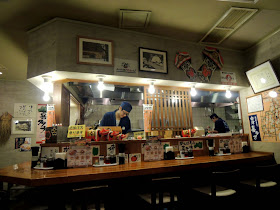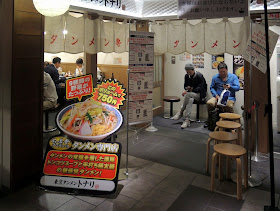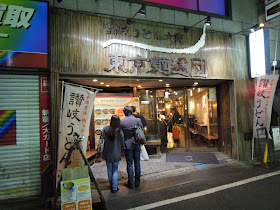Any trip to
Japan wouldn’t be complete without an obligatory boiled bone and carb-fest, and with over 4,000 ramen shops in Tokyo alone I knew we wouldn't be short of choice. Add in udon, soba and even instant (on average a Japanese person will eat 40 packs a year), and the Ewing and I were facing a fortnight of serious slurping.
The best noodles of the trip, ergo possibly ever, were the first bowl we ate - discounting the, very good, green tea soba offered up by Lufthansa on the flight over - at Shinjuku noodle bar Fuunji. It was perfect noodle eating situation; we had woken up (very) hung-over from excessive sweet potato soychu drinking the night before and the howling wind and pounding rain from the tail of typhoon Phanfone looked set to continue for another day.
Luckily my obsessive researching on Google maps had paid off and after a quick mid-morning powernap we grabbed our brollies and braved the inclement conditions to find some of the best Tsukamen noodles in town.
Fuunji, like many of the restaurants in Tokyo, has a vending machine ordering system; great to avoid those awkward ordering conversations, less great when all the buttons are in Japanese. Again, thanks to Google, I knew which one to press (the top right for the tsukamen with all the toppings) although somehow breaking the machine when trying to order wasn’t part of the plan.
Thankfully the staff were far too polite to dwell on this, so while one chef took our order verbally while another stripped reams of stuck paper from the bowels of the machine accompanied by the soundtrack of a beeping warning alarm, all while smiling beatifically at us.
Any awkwardness was soon forgotten (or at least replaced with a new sort of awkward as we tried to convey the strands of starch to our mouths) when the food arrived. This truly was noodle nirvana, a sort of other-worldly pinnacle for which I feel fairly confident now other noodles can never reach.
Tsukamen means dipping noodle, and the noodles at Fuunji are served cold to accompany a bowl of the most unctuous nectar that has passed my lips. Made from long boiling of chicken and fish the resultant broth is rich and creamy and mined with pieces of wobbly pork belly and a perfectly boiled egg - the exterior darkened by its soy marinade and an interior of gooey burnished gold.
In order to make sure not a drop is wasted, jugs of dashi stock are available on the counter, along with iced water, to lengthen the precious liquid so it can be drunk as soup. And that’s it; no salads or sides or fancy cocktails, no desert trolley or cheese and port. Just the finest experience I have had since the joy of coming home from school as a child and finding my mum had bought me and my sister a much lusted after chicken and mushroom Pot Noodle each (of course, that’s before I tasted it...).
Ramen is not something to be lingered over and despite being the first in the counter quickly filled and emptied next to us as a stream of salary men (and women) sat, slurped and said sayonara as we struggled to scarf down our scran as quickly as the locals while attempting not to wear most of it in the process.
Ramen is not something to be lingered over and despite being the first in the counter quickly filled and emptied next to us as a stream of salary men (and women) sat, slurped and said sayonara as we struggled to scarf down our scran as quickly as the locals while attempting not to wear most of it in the process.
Finally, the Ewing speared her final piece of slippery nitro egg and we rose, dazed by the glories of so much chicken fat so early in the day, made our goodbyes and squeezed our way past to the umbrella stand to prepare for the onslaught outside. But on opening the noren curtain we discovered that, rather like ourselves, things had changed for the better and there were finally blue skies overhead. The magical powers a bowl of soup possesses.
If you’re stuck in a railway station back in dear old Blighty, the best you can hope for is a curling M&S sarnie and a scalding cup of scummy dishwater chain store coffee. Thankfully before rail travel in Japan there is a variety of far more tempting sustenance, and Kyoto and Tokyo stations even have their very own Ramen Koji, or ramen ‘streets’.
These ramen streets are great for tourists and locals alike, as they showcase seven (Kyoto) and eight (Tokyo) regional noodle styles all in on handy location. As with most things in Japan, the real trouble is finding them, with the Kyoto Ramen Street most easily accessed through the small lift on the left hand side of the 2nd floor of the Isetan department store that’s attached to the station. After squashing in with an assortment of other noodle lovers ride up to the 10 floor, where you’ll find a sign - unhelpfully all in Japanese, helpfully with pictures - detailing the different types of ramen on offer.
On our first visit we were tempted by the sign advertising Masutani ‘A Kyoto favourite since 1948’. As with most noodle shops, payment is by the vending machines outside the shop; we both chose the most expensive ramen, at a whole 1,000 Yen a bowl (£6) and threw caution to the wind with a frosty Ashahi each, 500 Yen, and a dish of pickled radish to nibble on to start at 100 Yen.
After collecting our tickets the waitress showed us to seats on the counter where we could, just about, see the chefs labouring under a fug of steamy pots of boiling pigskin and pasta. Moments later and our bowls were in front of us.
Much is made of the rapidity of which the Japanese eat their noodles. It is claimed that the optimum amount of time to eat a bowl of ramen, to stop the noodles growing fat and claggy in the soup, is seven minutes. Couple this with the fact that most ramen are served at boiling temperature and you can see why slurping is not just encouraged, but essential.
The true Japanese slurp is not executed through poor technique, bad etiquette or even to show appreciation to the chef; instead the clump of piping hot noodles are lifted from the broth by chopsticks and then drawn into the mouth on a noisy raft of cooling air. Done properly the slurp magically cools the cargo from incendiary to just Very Very Hot. It’s also great fun to join in with the chorus of greedy sucking noises that make every noodle joint sound like a chorus bullfrogs has descended each dinnertime.
These ramen, described on the website as, ‘a bit strong-tasting soy sauce and high-quality back fat blended into the simple soup based on carcass… with rather thin straight noodle,’ were no exception with the murky layer of porky oil serving to keep even more of the heat in.
Despite not being much of a looker, the taste was rather good. The broth was unctuous and fatty without being cloying and the soy added seasoning and a little sweetness. Juicy slices of chashu and shredded nagi were present and correct and The Ewing also appreciated not one but two gooey-yolked eggs as I covertly shifted my nitamago to her bowl.
We like it so much we decided to go back for a quick dinner before catching the train back to Tokyo. This time we chose Kitataka Bannai, which are famed for their Kitakata-style noodles.
Kitatkata, as all good ramen fiend will know, is a town in northern Honshu known for its love of dough strands submerged in broth.
With an estimated population of 49,857 there are over 120 ramen shops in the city, or one shop for every 416 people. Ramen has such prominence in the region that locally, the word soba usually refers to ramen, and not to actual soba which is referred to as nihon soba (‘Japanese soba’), (thanks Wikipedia), and the locals love it so much that many eat Asa-Rah (morning ramen) for breakfast.
Kitakata ramen features thick, flat and curly noodles served in pork and niboshi (sardine) based, shoyu (soy) flavoured soup. Bannai Shokudo ramen is described on the website as 'a fantastic marriage of Soy sauce and salt based soup, in which umami of just pork bone was plainly and simply extracted, and rather thick hand-rubbing firm noodle!' Who could fail to be excited.
The home-made roast pork, toro uma char siu, is prepared in the restaurant every day, and comprises the only topping on their number one chashu pork ramen. Normally thick, sweet fatty slices of pig would also top my number one ramen, but, after a day at Nishiki food market I scaled back a bit with the Kitakata ramen, which also features shredded Japanese leek alongside the slabs of meat.
As you can see from the picture, this was a far lighter soup than the one we had tackled the previous night. Usually I would favour the thick, funky pig-enriched broth, but this slightly sweet, salty soy-based number was delicate while still being imbibed with a deep fishy, porky flavour. Even better the small portion, pictured, came in at 6oo Yen (£3.60) which left plenty of money for train beers on the Shinkansen back to Tokyo.
We enjoyed ramen alley in kyoto so much that we decided
to hit the original, in Toyo station, when we go back (actually this may be a
small fib; I wanted to go there to buy oddly flavoured and impossible difficult
to find Japanese Kit Kats, and the shop that sold them was directly opposite
Raman Alley…).
The most famous, and popular, of the eight Tokyo offering
is Rokurinsha, known for their tsukamen. After the offerings at Fuunji, I
didn’t want to besmirch my magnificent memories of dipping noodles so we went
in search of something a little different.
Which is how we ended up at Tonari, whose specialty is steaming bowls of tantanmen, or Chinese style ramen. Thoughtfully they provide paper aprons, which were also offered to the couple that were sat next to us, although I’m not sure if this was to protect their spotless white shirts before returning to work or make the Gajin next them feel slightly less socially awkward.
We both chose a set, my was the super-duper Toyo station special of tantanmen with a whole nitrotamago and a juicy slice of pork belly accompanied by a fearsome (not that fearsome, but hot for Japanese standards) dish of spicy chilli oil and a side of kara age which, rather remiss of me, was the first of the whole trip.
Here's the Tonari style tanmen, described on their sign as 'salty pork bone soup and voluminous wide noodles topped with eight types of sauteed vegetables - including Japanese mustard spinach, bean sprouts, Chinese cabbage and garlic chives - boiled fish cake, squid tentacles and pork.'
This was about as healthy as ramen gets – if we ignore the (probably) astronomical sodium levels, pig-infused broth and great curl of cured meat on top – with the thicket of veg and chewy curly noodles going down very well, and very noisily, on what was turning into a rather dull and dreary autumn afternoon.
The karaage was everything I hoped, with its blistered and gossamer thin carapace giving way to hot, juicy, slightly greasy chook that went very well with an extra slick of the chili oil and a large bottle (three quid) of ice cold Asahi.
The Ewing picking the rather restrained regular bowl, which came with the same thatch of toppings, less the bacon and egg (of which I was happy to share the latter.) Her set was accompanied by some very good, perfectly squirty within, pork and veg gyoza.
A very nice pit stop, and certainly worth a punt if you are wanting to top up your 5 a day, or ever tire of the richer, saltier Tokyo Shoyu or creamy tonkotsu style broths (yes, I know, unlikely…).
A very nice pit stop, and certainly worth a punt if you are wanting to top up your 5 a day, or ever tire of the richer, saltier Tokyo Shoyu or creamy tonkotsu style broths (yes, I know, unlikely…).
Of all the (Eastern-style) noodles, udon may just be my favourite. Big, fat, wiggly strands of wheat, they are the noodles that put London’s Koya on the map, as well as being great when stir fried (especially with lots of pork and shredded ginger).
A tip provided by this great Serious Eats article (they also mention Fuunji) was Shinjuku’s Mentsu Dan, an informal canteen style noodle and tempura restaurant tucked away in the streets north of the JR station, which is where we found ourselves after a busy day shrine-hopping.
The noodles are handmade daily and the various preparations - hot hold, dipping, soup etc. – are posted on pictures (helpfully colour co-ordinated red and blue) on the window outside. Not much trusting our Japanese skills we took a couple of pictures to show the chef, but were thankfully saved when a rather lovely young lady stepped in to help us.
I chose the 'bukake' (or splashed) noodles. Yes, to those with a knowledge of 'adult' films this may sound slightly alarming, as a friend on twitter pointed out, but on trying a mouthful of these its hard to not be moan like a leading lady (don't worry, I restrained myself).
Apart from the superlative noodles I also loved the slender purple, pickled aubergines and the crunchy carrot and radish with sesame. The tempura were a little less successful, mainly owing to the fact that anything that's been immersed in the fryer needs to be eaten pronto lest it turns into a greasy sponge; a fate which sadly befell the green spiky thing (cabbage?) that looked so beguiling, but shattered into oily shards on eating.
That said, the potato croquette was good, as was the slice of kabutcha squash and the butterflied sardine the Ewing picked seemed to disappear pretty quickly. The Ewing's noodle choice, the classic cold udon served with a dipping sauce, was also spot on, if pretty tricky to eat, but that paled into insignificance when compared to the egg custard she had picked up from the cabinet for desert that was later attacked with nothing but chopsticks....
A special mention to our savaviour at the noodle ordering counter; not only did she explain our choices to us – both cold preparations, to highlight the bite noodles – she also went to get us drinks of iced water after we had sat down and even offered to take a picture for us before she and her friend left (despite arriving as we did, they had eaten their meal and had a chat and a post-noodle cigarette while, needless to say, our food was still barely touched, with more of it on the floor and the table than in us).
Our last night in Japan started like the beginning of our trip, with a deadly typhoon. Being Brits, and made of sterner stuff than letting a little category four cyclone dampen our spirits, we went for a rather wet and windy walk around Shinjuku before ending up - cold, tired and bedraggled - at the handmade soba restaurant in the mini shopping complex in the basement of our hotel.
Our last Japanese meal mirrored our two first as the Ewing chose soba noodles and I had a bowl of comforting kare raisu, with carrots, pork and sweet potatoes, for a frankly unbeatable 280 Yen (£1.60). We also pushed the boat out with two giant tempura prawns, almost a bank-breaker at a whole 120 Yen (72p) each, and gloriously hot and crisp from the fryer.
The soba were equally good, made on the premises and accompanied by a distinctly autumnal melange of aubergine and squash in a thin dashi and mirin based broth. Soba are a noodle I sometimes struggle to like, seeming so, well, parsimonious next to their bigger, louder cousins, but these were restrained and nutty with a lovely, delicate bite.
As if there was any doubt that these were enjoyed I’ll leave you with this picture of the Ewing, eyes firmly down and, despite more than passable chopstick skills, more soba on the table than on the zaru tray. Proving that after two magical, intoxicating, challenging, exhilarating weeks, you can never tire of the novelty of noodles.


















































